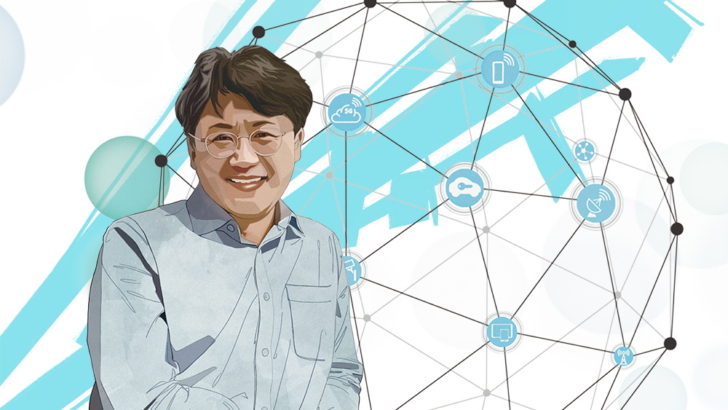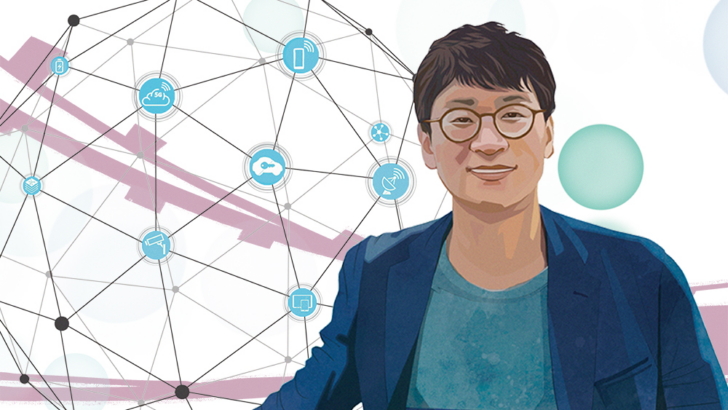[What’s Next in Communications Technology?] ④ Defining the Boundaries of Communications
on August 9, 2020

The True Value of Standardization
Communication is about sharing information with others. The evolutions of communications technology has enabled us to be more connected than ever before, meaning that information can be shared anytime and anywhere.
In mobile communication, a business with a well-established global ecosystem, from equipment manufacturers to telecommunications operators, common rule is essential to keeping the ecosystem moving forward collaboratively. This is where the process of standardization comes in, which sets internationally agreed-upon standards to give users access to better products and services at lower prices. A representative example demonstrating the benefits of international standardization is the global roaming service, which allows users travelling to foreign countries to use their mobile devices as they are.

Standardization is one of main driving forces behind the growth of the mobile communication industry since a new generation has been introduced once every decade. “Large-scale investments into mobile communication have been triggered when each new generation of communications is commercialized,” explained Dr. Han. “When certain countries or companies run their businesses with proprietary solutions, the risk of failure increases.” This means that the chance of success can increase only when the stakeholders of the mobile communication ecosystem come together to define the most relevant technologies and discuss aspects like implementation early enough. “Determining communications standards and developing products following these standards is an equitable process,” noted Dr. Han. “These standards are crucial.”
Standardization is two-fold: the de jure standards obligated by regulators and the de facto standards established by the global communications industry which, while not compulsory, specify unified ways of operation for stakeholders around the world to follow. The Standards Research team of Samsung’s Advanced Communications Research Center oversees both standards.
“For example, in order to utilize the extremely high frequency band (mmWave) for 5G, de jure standardization is a prerequisite for the commercialization of any device using the band, which includes assigning a set of frequency bands to mobile communication, setting regulated conditions such as maximum transmission power and out-of-band emission, and ensuring its safety for the human body and existing devices,” explained Dr. Han. “We are also simultaneously developing protocol technologies and working on de facto standardization to include these technologies into the standards by participating in standards developing organizations such as 3GPP (3rd Generation Partnership Project) and IEEE (Institute of Electrical and Electronics Engineers).” Dr. Han emphasized that both de jure and de facto standards are equally important.
Working as a Communications Standard Expert
Frequency bands are a limited resource. It is inevitable that different parties will clash over acquiring such an in-demand resource, which is why each frequency band is already allocated to a specific purpose, e.g. fixed communications, mobile communication, broadcasting, satellite, or other uses. The extremely high frequency band adopted for 5G was an unexplored territory from the perspective of mobile communication. When Samsung initially proposed it, there was pushback at first.
Standards experts are supposed to take the initiative of reserving such new spectrums for the mobile communication industry. “By stressing mobile communication’s contribution to the economy, we managed to persuade the governments of each country, and attracted more supporters by showing them the feasibility of applying this extremely high frequency band to mobile communication,” recalled Dr. Han. “We actively presented many details to justify our claim, including the simulation results of a coexistence study. As a result, we were able to have this extremely high frequency band assigned to 5G.”

“There is no almighty judge when it comes to fairly determining which technology among many candidates should be selected as a part of the standard. Moreover, any technology has its own pros and cons,” said Dr. Han. “There is a decision-making process inherent to standardization. Proposals are first made by companies, intensive and technical debate on each proposal then follows, and participants finally build a consensus to reach a conclusion. We have to avoid sticking to our own interests. Instead, we are trying to communicate with other stakeholders to find the best way forward based on an understanding of the industry as a whole. When we take care of the ecosystem, proposals that we develop to make it healthy and sustainable will be supported by the majority as a result.”
Similar to the role of the diplomat, standardization experts participate in global standardization conferences and will there represent their company or their country. They are expected to be the best in their own field. “As we are contending at the forefront of these international discussions, technical competitiveness is the key requirement for Samsung delegates,” explained Dr. Han. “Therefore, in our projects, anyone who is most competitive in a certain area is designated as the champion of the area, regardless which team he or she belongs to.”
Standardization, the Next Phase of 5G
4G is a communications technology designed to enable the wireless broadband service for smartphones. In particular, 4G as a universal communications platform aggressively adopted the Internet protocol that was popularly used in past wired packet communications. Therefore, many Internet-based services could easily migrate to cellular systems. 5G, then, is designed to expand its territory from the broadband service for smartphone users to vertical markets including the smart factory, automobile, healthcare, private network, smart city, and more. 4G as a universal solution led to a huge growth of the communications market. On the other hand, 5G aims to create new markets based on its new design principle of customizable networks to fulfill the specific requirements of a particular industry sector.
To realize the innovations that 5G has promised, Dr. Han and his team have been working on Rel-16, the second version of 5G. “Rel-15, the first version of 5G, laid a new framework for the technology and focused on how to provide differentiated experiences to conventional customers, i.e. smartphone users,” noted Dr. Han. “We joined the global collaboration to develop Rel-16 in order to realize the 5G vision. Rel-16 introduces and enhances 5G’s features for vertical markets. For example, V2X1 is for connected cars, industrial IoT communications is for smart factories and the data analytics function has been improved for network AI.”
Even though 5G has been commercialized, the standardization of 5G for further enhancements will never stop. Until the launch of 6G, the 5G standard will continuously evolve in order to improve and expand 5G. “As soon as we concluded the development of 5G’s second version, we immediately began work on the third version, Rel-17,” commented Dr. Han. “We have discovered some areas to improve commercial 5G networks with, including coverage expansion and NR-MIMO (Multiple Input Multiple Output). These will be amended and enhanced in the upcoming versions. Furthermore, we will continue to discover new features to add in order to enable new 5G applications. Innovations we are looking at include media delivery for AR glasses-type devices and edge computing enablers for low latency services from cloud servers close to users.”
Standardization of Edge Computing, Further Enhancement for 5G Services
Samsung is constantly pushing the boundaries of 5G in order to bring its unique experiences to users. One key characteristic of 5G is its ultra-low latency, brought about by its nine-tenths latency reduction in the radio access link between terminal and base station as compared to the previous generation. In order for users to experience the quality of ultra-low latency services, the end-to-end latency between the user terminal and the cloud server should be reduced. Samsung believes that edge computing will solve the rest of this puzzle, this being latency reduction in the backbone network, by placing the server closer to users. Thanks to 5G and edge computing, users will finally be able to enjoy 5G’s signature service on their devices.
“The link between a device and its server was out of 3GPP’s scope,” said Dr. Han. “But it is also hard for other standards organizations who are not experts in 5G to develop the standard for edge computing without a complete understanding of 5G systems.” Due to this difficulty, attempts were made to develop edge computing-enabled communication using proprietary solutions – which would lead to serious market fragmentation. “Samsung initiated discussions on edge computing inside 3GPP and persuaded other participating companies. We are now leading the standardization effort for enabling edge computing in 5G systems as one of the key items of Rel-17.”
In 2009, Samsung began the early stages of 5G research with the question of “how can we improve cellular networks to be 10 times better than 4G LTE?” Samsung will continue to develop further enhanced technologies for the future of 5G. “Samsung plays various key roles in the influential standardization organization for mobile communications and leads those standards and related technologies,” explained Dr. Han. “Based on our perseverance for over 10 years in this field, we will overcome whatever obstacles we encounter and will make 5G a big success.”

Making a Better World – Through Technology
Dr. Han began working in this field because when he was a student, he was extremely curious about who made standard specifications, the ground rules that were akin to a communications bible. And today, he is leading the team shaping the future of communications with standards. What resolution has he set?
“When we worked on LTE standards, we did not even expect that the term ‘LTE’, back then only used by selective standard engineers, would become a common and popular term,” noted Dr. Han. “This experience reminded me that the technologies we create can change the world and the daily lives of people. We are also aware of high expectation from 5G that we have developed. I firmly believe that our work will benefit the world.”
Dr. Han is also working on promoting Samsung’s 6G vision to inspire people in this field. “In the future, the main customers in the communications market won’t just be human, but will include robots and other machines, too,” explained Dr. Han. “People will start to enjoy hyper-connected experiences and be able to explore reality in a virtual world without temporal or spatial constraints. 6G will present fundamental technologies for such innovations. We will begin communicating with stakeholders as per Samsung’s 6G White Paper, published on July 14. Our 5G experience and the insights captured in our 6G vision will help us prepare for the long journey toward another success story with 6G.”
“Moreover, the sustainable growth of society and the communications industry will be key considerations for shaping 6G.”

1 V2X is a technology that supports vehicle-to-vehicle and vehicle-to-infrastructure communications.



